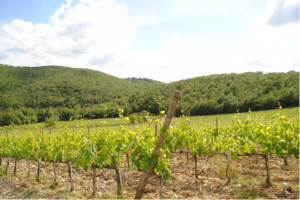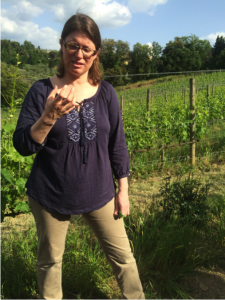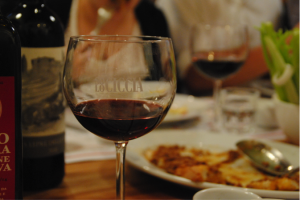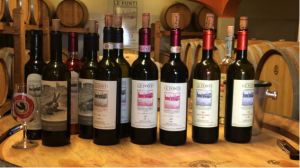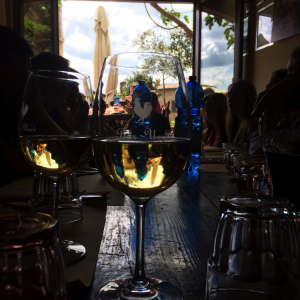One of the main intentions of our time in Panzano is to understand the Italian culture of food and wine. In addition to learning about these topics in a classroom setting, we have been lucky enough to visit many different wine producers, butcher shops, gelaterias, and other places that make items that are typical of the Tuscan region. After visiting wineries, including Le Fonti, Le Cinciole, Nittardi, Le Mortelle, my interest for wine production sparked. We have had the opportunity to take tours of their vineyards, wine cellars, to taste their wines, and to see the hard work that must be put into running a vineyard. In addition to visiting these sites, we have also been able to understand the different marketing aspects that are used in tasting sessions through the information gained in our class time.
Before this class, I knew very little about wines and wine production, but since my arrival in Panzano I have greatly expanded my knowledge of wines, among many other things. One thing we have focused on throughout our class has been the production of the most famous wine of this region: Chianti Classico. Because we have been immersed in a Tuscan culture that is very proud of the wines it produces, I became increasingly curious about the history of the Chianti Classico.
The Recipe for A Chianti Classico
At almost all of the vineyards we visited, the emphasis of the tastings was put on the Chianti Classico. It was easy to see that creating this type of wine is something to be proud of. There are quite a few strict rules that a producer must follow in order for their wine to bear the name Chianti Classico, but after the completion of all of the requirements, it makes the title of Chianti Classico well deserved.
It is essential for the vineyard to be a part of the Chianti wine region for the wine to be a Chianti Classico. There are no exceptions. This region lies in the heart of Tuscany, between Florence and Siena, and includes Radda In Chianti, Greve In Chianti, Castellina in Chianti, Castelnuova Berardegna, Poggibonsi, Berberino Val d’Elsa, Tavarnelle Val di Pesa, and San Casciano in Val di Pese. Although the Chianti wine region is considered larger than the area these towns cover, this area is the only place in which a vineyard can produce a Chainti Classico.
Another equally important part of creating a Chianti Classico is the creating a proportional blend. In addition to finding the perfect blend for the current market, it is essential for the producers to follow a very rigid guide to create the Chianti Classico. In order to be called a Chianti Classico, the wine must be at least 80% Sangiovese grapes, many wines have more than this. The remaining 20% of the blend can be any other type of autochthon red grape, most often Cabernet and Merlot. Among other regulations, the wine must have a minimum alcohol content of 12 degrees and must be aged for a minimum of seven months in oak.
When the wine is finished, the winemakers send samples to the Consorzio vino Chianti Classico for testing. This is when the wine is tasted and tested to see whether the wine fits the standards of the Chianti Classico. When the winemaker sends the sample of the wine, they must also send the amount of bottles they will be producing. If the Consortium approves the wine, the producers will receive the exact number of labels that they requested. A number is put on each label that is unique to each bottle of Chianti Classico that is produced. Because the Chianti Classico wines are popular, many producers market their wines Chianti Classico’s even though they are not. They may replicate the label, but if it seems counterfeit, one can check the identification number online. If the wine presented online is not the one that you had bought, you can report the wine to the Consortium and there will be severe consequences for the producer at fault.
The History of The Chianti Classico
After speaking with wine producers and researching the production of Chianti Classico, I discovered some information about the origin of the wine. The Chianti Classico wine is native of the area of Tuscany in which we have been staying in for the past few weeks and wine can only be produced in this specific region of Chianti. When digging deeper into the history of the Chianti Classico, I found that the first record of the exporting of wines from the Chianti region was in 1398. The wine then became increasingly popular in the following centuries due to its unique and acidic flavor. With the rising popularity of the Chianti wine, many wineries began to advertise their wines as Chianti even though they were not produced in the Chianti area.
In order to reduce fraud and protect the unique taste of the Chianti wine, Cosimo III Grand Duke of Tuscany declared borders of the Chianti region in 1716. This document indicated the progression toward distinct wine making regions and deniminazione di origine controllata e garantita (DOCG). This documents shows how important the Chianti region is in the history of wine production. Although the new borders were added in an attempt to prevent fraud, there were still counterfeit wines being produced.
In 1924, a new group of vineyards met to create a new set of guidelines for the protection of this important wine. Thirty-three vineyards met to make up the “Consortium for the defense of Chianti wine and its symbol of origin.” This new consortium had a goal to maintain the high demand for the Chianti wine by removing producers that were not making quality wines. Because the original borders of the Chianti region were expanded in order to create more wines due to the increased demand, by 1932 there were many other types of Chianti wines. To protect and distinguish the original Chianti wine from these new types, they made the region smaller by tightening the borders and Classico was added to the name, creating the Chianti Classico. In 1984, the Chianti region gained a DOCG and in 1996 the Chianti Classico received its own DOCG.
Before the 1990s, the recipe for Chianti Classico was 80% Sangiovese and 20% white wine, most often made from Trebbiano grapes. While Sangiovese grapes are red and rather acidic, the Trebbiano grapes are white and crisp. After hearing this from Lèon at Nittardi, I was taken back. We have heard from many producers about how the Chianti Classico was known for it’s deep red color and use of Sangiovese grapes. Lèon talked about how the Nittardi property was once owned by Michelangelo and his nephew and there they made wine with Trebbiano grapes. There are letters documented from Michelangelo to his nephew during the time he was painting the Sistine Chapel in the 1400s. Michelangelo inquired about how the grapes are doing and asked his nephew to send a bottle so he could give it to the pope.
To get another perspective, I spoke with Vicky Schmitt-Vitali from Le Fonti. We spoke about the history of the Chianti Classico and I learned that from the 1700s until 1993, white wine was required to be in the Chianti Classico blend. In 1993, there were new rules that allowed the producer to decide whether the remaining 20%, after the 80% Sangiovese, would be white wine or red but in the early 2000s, the Consortium required the remaining 20% to be red. I was very curious as to why, after hundreds of years, the Chianti Classico was changed to exclude white wine completely.
When I asked Vicky her thoughts on this topic, she replied with the same answer that most of my research led me to: white wine simply does not age well. People were not able to keep the bottle for more than 2 years, at most. The wine would spoil and turn a brown color. Because the market trends show that many people buy wine as an investment having a wine that spoils quickly was not profitable. Lèon, from Nittardi, stated that it was because it didn’t taste very good. I did more research online and found more of the same answers: white wine causes the wines to be weaker and to not age well. Although these arguments make sense, I am still left to wonder how, in a land firmly based on the traditions and memories of ancestors, did the people decide to remove white wine completely from the Chianti Classico after hundreds of years.
The Other Chianti Wines
This question has plagued my curiosity since our visit to Nittardi and I have found no other explanation. I began researching the other Chianti wines to see if any of them have continued using white wines in a blend with red. There are now seven other Chianti wine regions, including Colli Fiorentini, Montalbano, Rufina, Montespertoli, and Colline Pisane, which prohibit any white grapes in the wine. Although these regions of Chianti wines prohibit the use of any white wines mixed with red, both Colli Aretini and Colli Senesi allow white wine. Colli Aretini is made with at least 75% Sangiovese, up to 10% Canaiolo, up to 10% Malvasia or Trebbiano, and up to 10% of other red grape varieties that are permitted by the consortium. Colli Senesi is made from mostly Sangiovese, as well as Canaiolo, Colorino, cabernet Sauvignon, and Merlot. It also can have up to 10% Trebbiano and Malvasia until 2015.
The fact that two of the seven Chianti wines still allow white grapes is very interesting. There is no information presently published about why these two regions of Chianti still include white wines while the other ones do not other than because they are easier to produce in large quantities. Many wine consumers buy wines as an investment to sell after ten years of aging but more and more consumers today are buying a bottle and drinking it within a year or two. I wonder how the wines of Colli Aretini and Colli Senesi will compete in this market. It is interesting to see that a few wineries still mix white and red and that there is no reason to justify the change to only red grapes other than the taste and short shelf life of white wine. It is fascinating that a culture so strongly rooted in tradition dismissed this type of wine after hundreds of years.
Works Cited
“Chianti.it.” Chianti Colli Aretini, Prodotto Esclusivamente Nella
Provincia Di Arezzo. Tour Operator Iscrizione Regione
Toscana, n.d. Web. 11 June 2014. <http://www.chianti.it/pianetavino/colli_aretini.php>.
Chianti Colli Aretini, Prodotto Esclusivamente Nella Provincia Di
Arezzo. Tour Operator Iscrizione Regione Toscana, n.d. Web. 11 June 2014. <http://www.chianti.it/pianetavino/colli_aretini.php>.
“Chianti Colli Senesi Wine.” Chianti Colli Senesi Wine. Wine-
Searcher, n.d. Web. 11 June 2014. <http://www.wine-
searcher.com/regions-chianti%2Bcolli%2Bsenesi>.
“Chianti Wine, ItalianWine.com.” Chianti Wine, ItalianWine.com.
N.p., n.d. Web. 11 June 2014. <http://www.italianwine.com/chianti-wine.shtml>.”Chianti.it.”
“Chianti and Tuscany Wine Grape Varieties.” Chianti Tuscany Grape Varieties. N.p., n.d. Web. 11 June 2014. <http://www.chianti-chianti.info/>.
“Il Vino Chianti Classico.” Consorzio Vino Chianti Classico. Il
Consorzio Del Vino Chianti Classico, n.d. Web. 11 June 2014. <www.chianticlassico.com%2Fvino%2Fil-vino-chianti-classico%2F>
“The Wines of Chianti ClassicoPart I.” The Wines of Chianti
Classico. Tom Cannavan, n.d. Web. 11 June 2014.
<http://www.wine-pages.com/features/chianti-classico.htm>.

